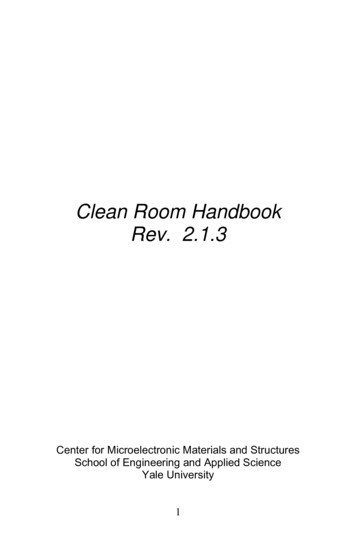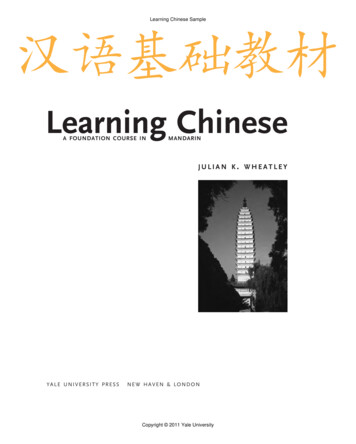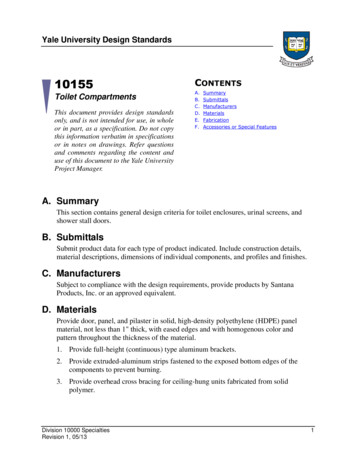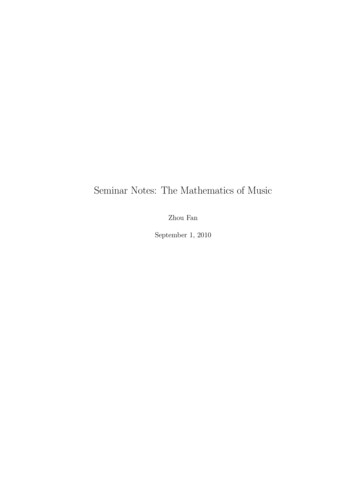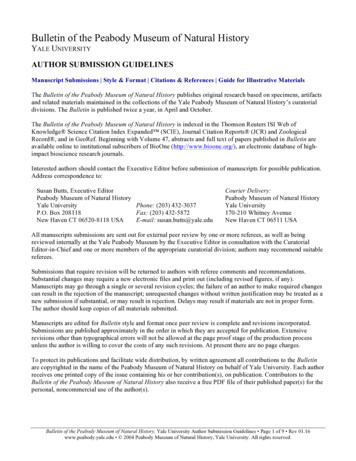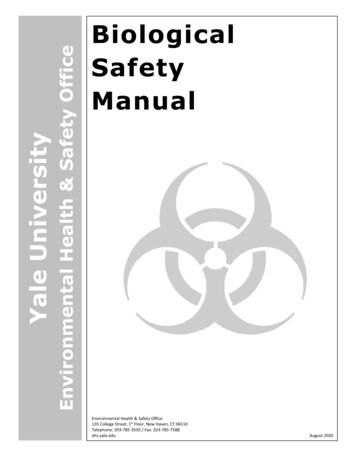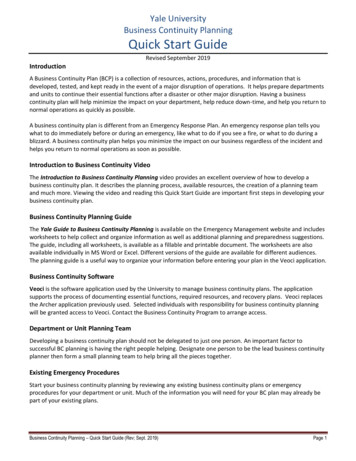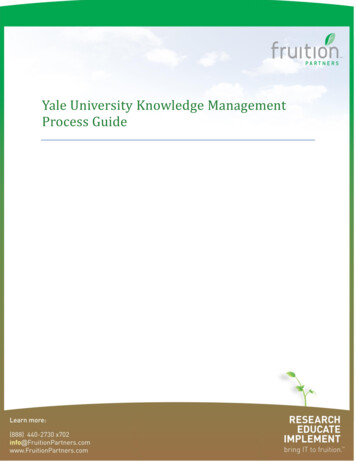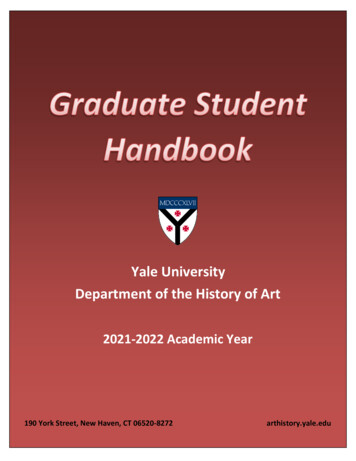
Transcription
Yale UniversityDepartment of the History of Art2021-2022 Academic Year190 York Street, New Haven, CT 06520-8272arthistory.yale.edu
YALE UNIVERSITYDEPARTMENT OF THE HISTORY OF ARTGRADUATE STUDENT HANDBOOKTABLE OF CONTENTSGENERAL INFORMATIONStructure of the Department1CollectionsYale University Art GalleryThe Yale Center for British Art344LibrariesRobert B Haas Family Arts LibraryOther Yale LibrariesWest Campus5566ADMISSION & FINANCIAL ASSISTANCEObtaining an Application7Admission Process7Financial AssistanceUniversity Dissertation FellowshipSixth Year Funding899Graduate Teaching Fellows / Research AssistantshipTeaching FellowsGraduate Research Assistantship (GRA)111111PROGRAM OF STUDYFaculty Advisers13Courses13Requirements & Procedures14RegistrationAuditing CoursesDissertation Completion Status7th Year Extended Registration8th Year Extended RegistrationRegistration in AbsentiaSpecial Graduate Course NumbersExchange Scholar Program (IvyPlus Exchange)Leave of AbsenceWaiving of Course Requirements16161616171717181818Grades, Evaluations, & Temporary IncompletesGrades1919i
EvaluationsTemporary Incompletes1919Languages20MA Degree21MPhil Degree21The Frick Symposium & Other Forums for Graduate Papers21PHD PROGRAMProvisional Admission to CandidacyDetailed DescriptionQualifying PaperQualifying ExaminationsPlanning Qualifying ExaminationsColloquiumRegistering the Dissertation TopicFirst Reading of Chapter(s) of the DissertationDissertation DefenseDissertationEmploymentVerification of Degree222223232425262727282929COMBINED PHD PROGRAMSHistory of Art & African American Studies30History of Art & English31History of Art & Film and Media Studies33History of Art & Renaissance Studies36PROGRAM REQUIREMENTS SCHEMATICSHistory of Artii38-39History of Art & African American Studies40History of Art & English41History of Art & Film and Media Studies42History of Art & Renaissance Studies43
GENERAL INFORMATIONSTRUCTURE OF THE DEPARTMENTThe History of Art faculty offers courses across a broad spectrum of areas of art history. Eachmember of the regular full-time faculty teaches both graduate and undergraduate courses. Anumber of faculty in other departments and curators hold Affiliate Faculty appointments in Historyof Art.Because of the sabbatical system, about one out of six faculty members can be expected to be onleave of absence at any given time. The following list indicates the fields of specialization of thecurrent full-time faculty:Carol ArmstrongNineteenth-Century European Art, French Modernism,History of Photography, Women Artists and Feminist ArtHistory, Art Criticism and its History, Art and Science,Theory, Methods and HistoriographyTim BarringerVictorian Visual Culture, British Art 1700 to present,American and British Landscape Painting 1750-1900,Nineteenth-century European Art, Post-colonial Studies,Gender StudiesMarisa BassNorthern Renaissance Art:1400-1700Craig BuckleyModern and Contemporary ArchitectureEdward Cooke, Jr.American Decorative Arts and Material Culture, GlobalCraftsJoanna FiducciaEuropean and American ModernismCécile FromontAfrican and South Atlantic ArtMilette Gaifman-Department ChairGreek Art & Archaeology, Greek Visual CultureJacqueline Jung- Director of Undergraduate StudiesMedieval European Art and Architecture1 Page
YALE HISTORY OF ART DEPARTMENT Graduate Student HandbookSubhashini KaligotlaIndian and South Asia Art and ArchitecturePamela Lee-Director of Graduate StudiesModern and Contemporary ArtMorgan NgItalian RenaissanceQuincy NganArt of Pre-Modern to Contemporary China, ChinesePaintingEuropean Art and Art Theory 1600-1800Nicola SuthorJennifer Raab-Placement OfficerAmerican Art, History of PhotographyKishwar RizviIslamic Art and Architecture:Mimi YiengpruksawanJapanese Art, Buddhist Art and IconographyThe number of graduate students on the roster has remained steady for some years at about sixtyfive. Of these, approximately forty are in residence in New Haven, while others are either doing fieldwork on their dissertations elsewhere in this country and abroad or writing their dissertations awayfrom New Haven. Among Yale undergraduates, there are about fifty junior and senior art historymajors, and some 1500 students registered in department courses.The Director of Graduate Studies (DGS) oversees the graduate program. In the first year, the DGShelps the student choose courses and settle on a field of specialization and an adviser/advisers.(Students may elect to have two co-advisers if they so desire.) Ideally the student will have chosenan adviser/advisers by the end of the first year of study. The DGS continues to give formal approvalto each student's course schedule each semester, oversees the Qualifying Examination, discusseswith the student the choice of the dissertation topic, and oversees the Colloquium in which this topicis presented for formal approval, and the reading of the dissertation. The DGS also arranges withthe student and the adviser the choice of examiners for the Qualifying Examination and the choiceof readers for the dissertation. The DGS oversees matters relating to Graduate School stipends andfellowships, although students should also be in contact with the Graduate School directly ifproblems or questions arise. The DGS and a faculty committee oversee the distribution ofdepartmental monies for research and travel. As of 2021, a Placement Officer will co-ordinate theDepartment’s professional development program.Each year three Department Representatives are chosen by secret-ballot election from amongstthe second- and third-year graduate students. One of those three Department Representatives iselected to act as Diversity Representative. The Department Representatives are offered a 500honorarium for each semester and are expected to represent both the graduate students and theDepartment as a whole in a professional and respectful way. Their duties and obligations include:Familiarizing themselves with the rules, protocols and norms of Yale University and theDepartment of the History of Art; attending all faculty meetings; collecting and articulating studentcomments and suggestions for presentation at faculty meetings; compiling a list of forthcomingstudent-organized events in the Department for internal circulation and presentation on theDepartment website; organizing a Departmental Orientation program for the new first yearstudents; collaborating with the Department in managing student input into the faculty hiringprocess, encouraging participation and collecting responses to each of the candidates; providingcrucial support for the graduate student recruitment process by collaborating with the DGS andGraduate Registrar in organizing the visiting day events for admitted students; collaborating with2 Page
YALE HISTORY OF ART DEPARTMENT Graduate Student Handbookthe faculty and staff on a regular basis in the organization of academic and social events in theDepartment; supplying to the Department regular news items on graduate student activities forthe Department website.The Department is currently housed in the Loria Center for the History of Art, a new building at 190York Street designed by Gwathmey-Siegel. Connected to Paul Rudolph's building for the School ofArchitecture, the Loria Center features departmental offices, faculty offices, classrooms, lounge,graduate IT room, and meeting rooms. In the lower floors of the Loria and Rudolph buildings is theArt and Architecture Library. Founded in 1868 in connection with the foundation of the Yale Schoolof Fine Arts, the first art school set up within a university, the library currently contains over 95,000volumes on the fine arts, including architecture, photography, graphic design and urban planning.It serves as the working library for the Schools of Art and Architecture, the Department of the Historyof Art and the Yale University Art Gallery, and as adjunct library for the Yale Center for British Art.The collection includes major reference works, monographs, histories, bound periodicals, andmuseum bulletins. It also houses special vertical file collections on artists, museums, art subjectsand city planning. Approximately 15,000 uncatalogued exhibition catalogs increase its resources.Other important parts of the library housed on York Street include the Art of the Book Collection andthe Visual Resources Collection (formerly known as the Slide and Photograph Collection). Theformer includes the Rollins Collection that focuses upon book design of the late 19th and early 20thcentury and a constantly growing collection of artists' books. Across York Street to the east is theYale University Art Gallery, the oldest university art museum in the United States, and diagonally tothe south east is the Yale Center for British Art. Further to the west up Chapel Street are the multibuildings of the School of Art. The adjacencies of all of these buildings, which link the practice andstudy of art and architecture, symbolize the particularly close interaction of activities thatcharacterize the study of the history of art at Yale.COLLECTIONSYALE UNIVERSITY ART GALLERYThe Yale University Art Gallery, besides being in itself a distinguished museum, is anindispensable adjunct to the teaching of the Department. It was founded in 1832 by the painterJohn Trumbull with his own works and with a building, making it the oldest university artmuseum on this continent. Some of its outstanding collections are: The Jarves Collection, primarily of early Italian paintings, acquired in 1871, which, combinedwith similar collections given later, make this the best university art collection of suchpaintings. The Dura Europos collection with the unique synagogue frescoes of the third century A.D.and close to 10,000 objects from the Yale excavation of this Roman outpost in Syria. The Garvan collection of American decorative arts, the finest in existence of American silverand notable also for its furniture. The Société Anonyme collection, assembled chiefly in the 1920s, contains ca. 1,000 worksby artists who were then very forward-looking, including, among others, Klee, Mondrian,Kandinsky, Duchamp, Man Ray, Schwitters, as well as many less well-known figures. The Stephen Clark collection, whose masterpieces include Corot's major early work, The3 Page
YALE HISTORY OF ART DEPARTMENT Graduate Student HandbookHarbor of La Rochelle, Van Gogh's Night Café, Frans Hals' pair of portraits of the Bodolphecouple, Winslow Homer's The Morning Bell, a number of important paintings by ThomasEakins, and others perhaps equally remarkable. The Ordway collection of 20th century art, notable for its splendid paintings from Vuillard toRothko. Significant Oriental, Pre-Columbian and African collections, Impressionist and other paintingsfrom the John Hay Whitney and Paul Mellon gifts, and many other works, round out thedisplays. A collection of prints and drawings of about 25,000 works is shown in rotatingexhibitions.Student involvement with the Gallery begins when undergraduates have class meetings thereand then write papers on original works of art. It continues with the teaching of courses by gallerystaff members. Graduate students are often involved with research on the collections and thepreparation of exhibitions. Some of the gallery's departments, notably Prints and Drawings andAmerican Art, can (as funds permit) offer part-time jobs, internships and fellowships to graduatestudents. Students are limited to spending ten hours per week in this form of employment. Seedescriptions below for details of the formal Graduate Research Assistantships offered by YaleUniversity Art Gallery (YUAG) and the Yale Center for British Art (BAC).In addition to its own staff, the Gallery usually appoints predoctoral or postdoctoral interns towork in curatorial departments each year following a national competition.Because only a small fraction of the total collection is on display, students are urged to learnabout works in their field not on view. Those doing research projects may use the Registrar'sfiles by making an appointment. The Print and Drawing collection invites students duringmuseum hours from Tuesday to Friday.Other relevant University collections are the Griggs Film Collection in the Audio-VisualDepartment, the collections of Egyptian, African, Native American and Oceanic works in thePeabody Museum, rare books and manuscripts in the Beinecke Library, the Babyloniancollection in the Sterling Library, and prints and drawings in The Medical Historical Library. Norshould students overlook the works of art throughout the campus, including distinguishedarchitecture and outdoor sculpture.THE YALE CENTER FOR BRITISH ARTThe Yale Center for British Art is both a public museum and a research institute. It was foundedin 1966 with an endowment and a collection given by Paul Mellon, '29. It opened in 1977 in abuilding designed by Louis I. Kahn which is one of the most noted works of architecture on thecampus.The collections survey British art from the Elizabethan age to the present, and are especiallystrong in the period from Hogarth through Turner. The 1400 paintings, 15,000 drawings, 25,000prints and 20,000 rare books are unequaled outside England. A reserve gallery is accessibleon the fourth floor next to the main galleries, and on the second floor a Study Room is providedfor research on prints, drawings and rare books. These collections also contain some important4 Page
YALE HISTORY OF ART DEPARTMENT Graduate Student Handbooksections that might not be expected, such as architectural drawings, and early book illustrationsfrom countries outside England. Similarly, the paintings include works executed in England bysuch notable visiting artists as Rubens and Canaletto. While the rooms devoted to Constableand Turner may be the most immediately impressive, the extraordinary paintings by less wellknown figures such as Stubbs, Wright of Derby and Richard Wilson are equally fine.The reference library of 12,000 books has open stacks. Its holdings of sales catalogs of the pastare very thorough (Sotheby's and Christie's catalogs up to 1980 are available in microfiches). Italso makes available books that one might not expect, such as sets of Greek and Latin classicalauthors and the Baedeker guidebooks to other countries.Classrooms in the building are used for seminars, and the auditorium, besides being used forlecture courses, houses frequent events, including symposia bringing groups of scholars todiscuss special themes, which are often related to exhibitions. A major laboratory forconservation of works on paper is located in the Center. The Center also hosts visiting scholarsdoing research projects on British art, literature, and history for stays of about a month; theseare announced at the beginning of the year, and the scholars may often be working on topics ofinterest to graduate students. There is a program of lunchtime meetings at which graduatestudents in the History of Art and other departments, as well as visiting scholars, present theirwork in progress.Graduate students may be appointed to part-time jobs as interns, and may also take part inorganizing exhibitions at various levels of responsibility. See below description for details of theformal Graduate Research Assistantships (GRAs) offered by the Yale University Art Gallery(YUAG) and the Yale Center for British Art (BAC).Graduate students in the field of British art are eligible to apply for a fellowship in London, at thePaul Mellon Centre, which is an affiliate of the Center. Students pursuing topics in British art arewelcome to use the library and extensive photo archive of the Paul Mellon Centre while they arein London.LIBRARIESROBERT B HAAS FAMILY ARTS LIBRARYThe Robert B. Haas Family Arts Library, housed in the Art and Architecture Building wasfounded in 1868 in connection with the foundation of the Yale School of Fine Arts, the first artschool set up within a university. It now contains over 95,000 volumes on the fine arts, includingarchitecture, photography, graphic design and urban planning. It serves as the working libraryfor the Schools of Art and Architecture, the Department of the History of Art and the YaleUniversity Art Gallery, and as adjunct library for the Yale Center for British Art. The collectionincludes major reference works, monographs, histories, bound periodicals, and museumbulletins. It also houses special vertical file collections on artists, museums, art subjects and cityplanning. Approximately 15,000 uncatalogued exhibition catalogs increase its resources.Carrels for graduate students in the History of Art department are located here.Several important microfiche collections (e.g., the Marburger Index, L'Index photographique de5 Page
YALE HISTORY OF ART DEPARTMENT Graduate Student Handbookl'art en France, the Deloynes Collection, County Courthouses of the United States, FrenchPopular Lithographic Imagery 1815-1870, Newsbank, smaller collections of Romanarchitecture, the Victoria and Albert Museum, etc.) are available in the Art and ArchitectureLibrary. All microfilm and additional microfiche material of interest to art historians are locatedin the microtext room of Sterling Memorial Library.OTHER YALE LIBRARIESThere are many other libraries at Yale with resources that are of special interest to the arthistorian (http://www.library.yale.edu) for a list of all Yale Library collections. The university'stotal holdings exceed 10.5 million separate items. The specialized resources of the British ArtCenter's Reference Library (http://www.yale.edu/ycba/library/library.htm) are described below.The Sterling Memorial Library houses approximately 80,000 volumes on the arts as well asmaterials in related fields, including most art historical materials in non-Roman languages. TheCross-Campus Library supplements this collection, mainly with books used routinely inundergraduate courses. The East Asia Library, housed in Sterling but a distinct entity, is one ofthe finest in existence. The Manuscripts and Archives Department at Sterling Library holdsoriginal architectural drawings of Yale buildings, and other primary source materials (see thehelpful list of their arts collections at http://www.yale.edu/ycba/library/library.htm. The BeineckeRare Book and Manuscript Library ) housesmany archival collections that are of particular interest to art historians, among them theMarinetti Archive, the Katherine Dreier and Naum Gabo papers, as well as a comprehensivecollection of early treatises on art and architecture and a remarkable collection of illuminatedmanuscripts. The special Anthropology, Classics, Divinity, Drama and Music Libraries, the Artsof the Book Collection at Sterling Library, and the Medical Library with its Historical Collection,are among the other libraries at Yale which should be explored by the art historian. Any searchof the Yale collections should begin with the card catalog at Sterling, which alone holds cardsfor all of the books in the Yale Library system, and with the campus-wide Orbis computernetwork, which now contains references to all books published in or after l978. A complete online catalogue of all holdings is in progress. Manuscript holdings are listed in the individual librarycatalogs. The librarians are happy to assist students and faculty in investigating the rich andcomplex library resources at Yale.The Yale Library provides a delivery service which permits readers to request materials frommost campus libraries at Yale. Requests can also be placed tm); so too can Interlibrary Loan requests formaterials from libraries elsewhere (http://www.library.yale.edu/ill/home.htm).WEST CAMPUSYale’s Institute for the Preservation of Cultural Heritage (which includes a Lens Media Lab)is a research collaborative, dedicated to the preservation and interpretation of materialculture. Its work connects Yale students, scholars, and collections, catalyzing wide-rangingpartnerships that bridge art and science in a unique space for learning, creativity, andinnovation.6 Page
ADMISSION &FINANCIAL ASSISTANCEOBTAINING AN APPLICATIONThe website for applications and the admissions process is chool.Yale University's Equal Opportunity StatementThe University affirmatively seeks to attract to its faculty, staff and student body qualifiedpersons of diverse background. In accordance with this policy and as delineated by federal andConnecticut law, Yale does not discriminate in admissions, educational programs oremployment against a handicapped person who is otherwise qualified or against any individualon account of that individual's sex, race, color, religion, age, or national or ethnic origin.University policy also affords affirmative action in employment to women, minority groupmembers, handicapped individuals who are otherwise qualified, special disabled veterans andveterans of the Vietnam era. Please see the Department website for its Diversity Statement, jointlyauthored by students and faculty, which is regularly updated.Underlying the fulfillment of these legal obligations is the University's commitment to basingjudgments concerning the admission, education and employment of individuals upon theirqualifications and abilities, and respecting an individual's privacy.ADMISSION PROCESSApplications for admission to the department's graduate program are reviewed by a facultycommittee chaired by the DGS. This committee makes recommendations about admission to theUniversity Graduate School on the basis of perceived merit; it does not take into account or havebefore it information concerning financial circumstances. On the basis of the department'srecommendations, the Dean of the Graduate School makes the final decisions about admission.The number of admissions that may be offered is constrained by Graduate School's resources. Thenumber of applications has risen in recent years, and admission can be offered only to about 7% ofapplicants. Many well-qualified applicants may not receive admission.7 Page
YALE HISTORY OF ART DEPARTMENT Graduate Student HandbookApplicants are required to submit a term paper or other writing sample. This should not exceed 20pages, and should demonstrate the applicant’s capacity for scholarly research in his or her mainarea of interest. The committee weighs the application materials with various points in mind. thetranscript, attention is given mainly to the art history courses, noting their quantity, variety, andgrades. If these are favorable, it is not always important whether the student was formally an arthistory major. The student's one-page statement of purpose is read carefully.Yale has a number of interdisciplinary graduate programs in which the Art History Department playsan important role; among them are African and African-American, American, East Asian, Film andMedia, Medieval, and Renaissance Studies. When the History of Art admissions committee hasfinished its work, applications not accepted by the department may be reviewed by appropriatefaculty members and transferred to the application pool of one of the above programs. If theadmissions committee in that program agrees, the student is then asked whether he or she wouldlike such a transfer to take place. As a result, a number of students in recent years have beenpleased to accept offers of admission to these Yale programs. Some of these programs are for theMA only, and their graduates may then apply to continue to the Ph.D. in art history; others are forthe doctorate itself.If interested in a campus visit, please contact individual professors and graduate students directlyvia e-mail to arrange your own schedule. Ideally visits should take place in the fall semester.Professors are not required to meet visiting students and volume of work often makes thisimpossible. Keep in mind that there is no requirement that a successful applicant visit campus. Evencomplex questions can be addressed via e-mail. Sending one's inquiries electronically also savesthe cost of traveling to and from New Haven.In choosing where to apply (or where to go, when accepted by several schools) students rightly putmuch stress on the fields of art history taught and on the known quality of the faculty. When one isdeciding where to go, it can be a great help to learn about the faculty. A simple way to do this is tolook at faculty web pages: http://arthistory.yale.edu/faculty/. Every year, students who have received an offerof admission but not yet accepted, are invited to come to Yale to visit the campus and to attend a departmentOpen Day.Deferred AdmissionsRequests for deferred admission will be considered only after an offer of admission has beenaccepted. Request for deferral must be submitted in writing to the respective associate dean,Ann Gaylin (ann.gaylin@yale.edu) who will communicate with the Graduate School’sdepartment or program. An admissions deferral may be requested for one academic year.FINANCIAL ASSISTANCEThe Graduate School currently offers full tuition and an annual stipend for five years of the six yearsof study to all admitted students. The annual stipend for 2021-2022 is 33,600 ( 12,600 per term and 8,400 for summer). During their second and third years, students are appointed as teaching fellowsfor four courses (one course/semester), unless a student receives a graduate researchassistantship (GRA) position from one of Yale’s galleries/museums. (see Graduate ResearchAssistantship below).8 Page
YALE HISTORY OF ART DEPARTMENT Graduate Student HandbookUNIVERSITY DISSERTATION FELLOWSHIPThe Graduate School awards every student a University Dissertation Fellowship (UDF) tosupport the writing of the dissertation. The University Dissertation Fellowship is taken in the fifthor sixth years.Students entering their fifth or sixth years who have not yet taken the UDF, have advanced tocandidacy, and are in good standing will be awarded the UDF as a default funding option. If afifth-year student decides instead to teach and postpone the UDF, a teaching appointment willcancel the postpone the UDF automatically. No additional action is necessary to affect thisdeferral of the UDF through teaching. Please be aware, however, that under normal conditionsno University funding, including the UDF, may be deferred beyond the sixth year of study.Students who have advanced to candidacy and wish to take all or part of the UDF prior to theirfifth year of study should email their request directly to the Office of Financial Aid atgradfinaid@yale.edu.Because of the 2020-2021 Covid-19 crisis, all students in the first- through sixth-year cohorts atthat time now have the option of a seventh-year extension, which is applied for at the end oftheir sixth year.SIXTH YEAR FUNDINGThe Graduate School of Arts & Sciences (GSAS) is providing funding for eligible students whoneed a sixth (and/or seventh) year to finish their dissertation. The new funding initiativeprovides a guaranteed teaching position or its equivalent at Yale to eligible sixth-year studentsand provides a stipend for up to nine months for the academic year. The teaching positionsmay be within, or in some cases, outside of their department or program, or in newly identifiedareas of professional development, such as assistantships in Yale’s collections, in digitalhumanities, and in the teaching of writing or other skills. Regardless of the nature of theirassignments, students will receive the standard departmental stipend in each of the terms inwhich they teach for up to nine months during the academic year. If no teaching is availablestudents will nonetheless continue to receive the stipend.Students currently in their fifth/sixth year of study and certified by their graduate program tobe on track to submit the dissertation by August of their sixth/seventh year of study are eligible.And, as has always been the case, no portion of the Yale financial aid package may be takenafter year six/seven.Eligibility for a sixth/seventh year of funding will be determined at the departmental level.Students must submit the Dissertation Progress Report (DPR). Departments will inform theGraduate School which students are eligible to be considered for the sixth/seventh year offunding from the DPR. In addition, the student must request Form026 – Sixth/Seventh YearFunding from the History of Art Graduate Registrar.As of May 25, 2016, the Continuing Registration Fee (CRF) will be covered by the GSAS forthose doctoral students registered within their sixth/seventh year who are teaching.For additional information please see the Graduate year-funding-initiative-faqswebsiteat9 Page
YALE HISTORY OF ART DEPARTMENT Graduate Student HandbookStudents with or without fellowships may borrow from federally sponsored loan programs.A number of other endowed fellowships administered within the department are available toHistory of Art students for travel and research in the summers and in the fifth year. The HenryS. McNeil Fellowships in American Decorative Arts are given to students in the first and lateryears in varying amounts; they are usually awarded to students in this department and inAmerican Studies and African-American Studies. The department makes possible small awardsfor photography, travel to conferences, and the like. The Blanshard Prize is awarded annuallyfor one or two dissertation(s) in art history considered by the faculty to be the best among thedissertations written in the department.In addition, the Georges Lurcy Fellowship is for study in France at the dissertation stage. In thepast, it has often been awarded to students in the History of Art. The Whiting and LeylanFellowships in the Humanities are for the final year of dissertation writing. Similar smaller grantsare awarded by the University's Council
History of Photography, Women Artists and Feminist Art History, Art Criticism and its History, Art and Science, . former includes the Rollins Collection that focuses upon book design of the late 19th and early 20th century and a constantly growing collection
